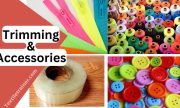A garments business in the highly competitive and dynamic USA market can be both exhilarating and daunting. The long-term success of fashion entrepreneurs must understand the essential steps and strategies. You will be provided with all the information and insights you need to start and grow a thriving garments business in the USA through this comprehensive guide. Throughout this article, we will guide you through the process of building a strong business foundation, starting with the initial planning phase. We will examine the key elements required to thrive in the USA market from conceptualizing your brand identity to identifying target customers, sourcing quality materials to establishing effective marketing and distribution channels. The USA is known for its fashion-forward consumers and diverse customer preferences, making it a lucrative but challenging market to penetrate. With the right knowledge and strategies, your garments business can stand out from the competition and succeed. In this guide, we’ll share expert advice, industry insights, and practical tips of successful fashion entrepreneurs who’ve succeeded in the USA. Implementing these steps and strategies will equip you with the tools necessary to make informed decisions and drive your garments business towards profitability and sustainability. So, whether you’re an aspiring fashion designer, an experienced manufacturer looking to expand your operations, or a passionate entrepreneur looking to make your mark in the fashion industry, this guide will serve as your roadmap to launching and running a successful garments business in the USA market. Let’s dive in and unlock the secrets to achieving your entrepreneurial dreams in the vibrant world of fashion.

Essential Step for Successful Business:
In order to run a garments business, you need to follow the following steps:
Step-1: Market Research and Analysis
Identify your target market, analyze their buying habits, and analyze the demand for specific garment categories before diving into the garments business. Understanding the current trends, consumer preferences, and competition in the USA market will help you develop a unique selling proposition.
The following factors need to be considered when conducting market research and analysis for your garments business in the USA:
- Demographics: Know your target audience’s age, gender, income level, and location so you can tailor your products and marketing strategies accordingly.
- Market Size and Growth Potential: Assess the size and growth rate of the garments market in the USA to determine whether it will support the growth of your business.
- Competitor Analysis: Study your direct and indirect competitors’ product offerings, pricing strategies, marketing tactics, and brand positioning. This will help you differentiate your garments and develop unique selling points.
- Consumer Trends and Preferences: Follow the latest fashion trends and consumer preferences. Your garments will resonate with your target customers if you adapt to popular styles, colors, materials, and sustainability preferences.
- Marketing and Advertising Channels: Your target audience can be reached with social media, fashion influencers, online ads, or traditional marketing channels. Determining the cost-effectiveness and reach of each channel will help you allocate your marketing budget.
With these factors in mind, you can gain a thorough understanding of the USA clothing market, enabling you to make informed decisions and develop effective strategies.
Step-2: Define Your Brand Identity
Brand identity is essential for fashion brands. Define your brand’s vision, values, and aesthetics. Determine the type of garments you want to offer, whether it’s casual wear, formal attire, sportswear, or a niche category. Identify your target market and develop a brand name, logo, and brand story that resonates with them. Following factor should be consider during brand identity.
- In order to create a brand vision, you should clearly define your brand’s long-term goals and aspirations.
- Identifying the core values that your brand stands for will enable you to build a brand that embodies them, such as sustainability, quality, or innovation.
- You need to identify the specific audience that you want to target with your garments so that you can design them accordingly.
- A Unique Selling Proposition (USP) is what allows your brand to stand out from those of your competitors and why the customer should choose your garments over those of your competitors.
- It is important to establish the brand personality traits and tone of voice that are associated with your brand, whether it is playful, sophisticated, or environmentally friendly.
Step-3: Create a Business Plan
A comprehensive business plan will serve as a roadmap for your garments business. Outline your goals, target market, product range, pricing strategy, marketing and sales plan, financial projections, and operational details. In addition to guiding you through each stage of your business, this plan will assist you in obtaining funding. Prior to creating a business plan, the following factors need to be considered:
- Executive Summary: It is imperative that you provide a concise summary of your garments business, including the key objectives, target market, and competitive advantage of your business.
- Market Analysis: Identify trends in the USA garments market, including customer demographics, industry trends, and competitor analyses, in order to conduct in-depth analysis of the market.
- Product Strategy: Outline your strategy for pricing your garments, how you will handle production, and how you plan to expand or diversify your product line in the near future.
- Marketing and Sales: Make a comprehensive marketing plan to promote and sell your garments. This plan should include branding, advertising, distribution channels, as well as strategies for acquiring customers.
- Operational Plan: Describe how your business operates on a day-to-day basis, including production, inventory management, and your relationships with your suppliers.
Step-4: Establish Supply Chains and Souring
Establish strong relationships with suppliers to ensure a consistent supply of materials and maintain product quality standards. Consider factors such as quality, pricing, lead times, and ethical sourcing practices. Establishing supply chains and sourcing involves the following factors:
- Supplier Selection: Assess potential suppliers based on their reliability, reputation, quality standards, capacity, and ability to meet your requirements.
- Cost and Pricing: To ensure competitive pricing for your garments, compare prices among suppliers, including raw materials, manufacturing, transportation, and any additional fees.
- Quality Control: Maintain quality control measures to ensure that the materials and finished garments meet your intended standards. This may involve conducting sample inspections, product testing, and communicating regularly with suppliers.
- Ethical Sourcing: Work with suppliers who share your commitment to responsible and ethical sourcing practices, such as ensuring fair labor conditions, sourcing materials sustainably, and observing environmental regulations.
- Supplier Relationships: Develop positive working relationships with your suppliers based on trust, effective communication, and mutual understanding. Communicate regularly with suppliers to address any concerns, provide feedback, and maintain a positive working relationship.
Step-5: Design and Development
Identify your target market and brand identity when developing a range of garments. Hire or collaborate with skilled designers to create appealing and marketable designs. Prototype and sample your garments to test their fit, functionality, and overall appeal. Continually refine and iterate your designs based on feedback. In the garment business, there are several factors that influence design and development:
- Market Research: In order to inform your design decisions, take the time to understand current fashion trends and consumer preferences.
- Concept Development: Consider factors such as aesthetics, functionality, and target audience appeal when developing garment designs.
- Materials and Fabrics: Make sure your design concept and target market align with high-quality materials and fabrics.
- Technical Design: Provide clear instructions for pattern-making, sizing, and construction in detailed technical sketches and specifications.
- Prototyping and Sampling: Make prototypes and samples of your garments to test fit, comfort, and overall quality. Make any necessary adjustments based on feedback.
Step-6: Set Up Manufacturing and Production
Determining whether you should manufacture in-house or outsource depends on your production needs. Establish efficient production processes and quality control measures to ensure consistent and timely delivery of your garments. When making manufacturing decisions, consider factors such as cost, scalability, and quality. Factors to consider when setting up a manufacturing and production operation:
- Production Capacity: Based on market demand and your business goals, determine whether in-house production or outsourcing to a manufacturing facility is most appropriate.
- Quality Control: To ensure consistent product quality, implement processes to inspect raw materials, monitor production stages, and conduct final inspections before distribution.
- Supplier Selection: Identify reliable suppliers for raw materials and components. Analyze their track record, quality standards, pricing, and delivery capabilities.
- Manufacturing Equipment: Based on your production requirements and budget, purchase or lease the necessary manufacturing equipment, such as sewing machines, cutting tables, pressing equipment, and specialized tools.
- Skilled Workforce: Train skilled workers in garment production, including pattern-making, sewing, and quality control. Invest in ongoing training and development to ensure a competent and efficient workforce.
Step-7: Build an Online Presence
Create a professional website that showcases your brand, product range, and brand story. In today’s digital age, having a strong online presence is crucial. Optimize your website for search engines and ensure it offers a seamless and secure shopping experience. Promote your garments via social media platforms to engage your target audience. Developing an online presence involves the following factors:
- Professional Website: Design a user-friendly website that showcases your brand, product offerings, and brand story. Optimize it for search engines to increase visibility.
- Social Media Platforms: Become active on social media platforms where your target audience is active. Develop a consistent posting schedule and engage with your followers to build brand awareness.
- Content Marketing: Create valuable and relevant content, such as blog articles, videos, or infographics, to educate and engage your target audience. Share this content on your website and social media platforms to establish yourself as an industry expert.
- Search Engine Optimization (SEO): Improve your website’s rankings in search engine results by optimizing its content, meta tags, and URLs with relevant keywords.
- Online Advertising: Develop compelling ad campaigns with clear calls-to-action to increase conversions using online advertising channels like Google Adwords or social media ads.
- Email Marketing: Build a list of interested customers and create email campaigns to nurture and engage them. Send them personalized product recommendations, exclusive offers, and brand news.
Step-8: Marketing and Sales Strategy
In order to increase awareness and sales, develop a comprehensive marketing and sales strategy. Reach out to your target customers using social media advertising, influencer collaborations, email marketing, and content marketing. Expand your reach by participating in fashion trade shows, pop-up events, or partnering with local boutiques. A marketing and sales strategy should consider the following factors:
- Target Audience: Identify your target audience based on their demographics, interests, and purchasing behaviors. Understand their needs and preferences.
- Positioning and Differentiation: Identify and communicate your unique selling points clearly to stand out from your competitors. Define how you want your brand and garments to be perceived in the market.
- Marketing Channels: Choose the most appropriate marketing channels to reach your target audience. This may include digital marketing (website, social media, email), traditional advertising (print, radio, TV), or a combination of both.
- Content Strategy: Using blog posts, videos, social media posts, and influencer collaborations, develop a content strategy that aligns with your brand and engages your audience.
- Brand Messaging: Communicate clearly the benefits and value of your garments to capture interest and drive sales by crafting a consistent and compelling brand message.
Step-9: Establish Distribution Channels
Decide on your distribution channels, whether it’s selling directly to consumers through your website, partnering with e-commerce platforms, or partnering with retail stores. Choose the channels that align with your brand and target market after evaluating their pros and cons. Establishing distribution channels requires the following factors:
- Target Audience Accessibility: Choose distribution channels that make your products easily accessible to your target audience, based on where they tend to shop for garments.
- Online Presence: Your website or e-commerce platform can significantly expand your reach and provide customers with a convenient way to purchase your garments.
- Retail Stores: Your garments can be showcased and sold in retail stores that align with your brand and target market.
- Boutiques and Specialty Stores: A collaboration with boutiques or specialty stores that specialize in specific fashion niches can help you target a more focused customer segment and create a unique selling proposition.
- Fashion Marketplaces: Online fashion marketplaces such as Amazon, eBay, or specialized fashion platforms can provide a wider customer base and additional marketing exposure for your garments.
Step-10: Monitor and Adapt
Analyze customer feedback, sales data, and market trends to make informed decisions about your garments business. In order to remain competitive in the ever-evolving USA market, stay adaptable and open to making necessary adjustments to your product offerings, marketing strategies, and operations. In your garment business, you should monitor and adapt to the following factors:
- Sales Performance: Analyze trends, identify patterns, and find out which products are selling well and which ones need improvement by tracking sales data.
- Customer Feedback: To continuously improve your products and customer experience, actively seek feedback from your customers through surveys, reviews, and direct communication.
- Market Trends: Monitor changes in consumer preferences, emerging styles, and new innovations in the industry and adapt your product offerings and marketing strategies accordingly.
- Competitor Analysis: Identify opportunities for differentiation by monitoring your competitors’ product launches, pricing strategies, marketing campaigns, and customer engagement efforts.
- Technology and Digital Advancements: Make use of e-commerce platforms, social media advertising, data analytics tools, and other digital solutions to improve efficiency, reach customers, and drive sales.
Conclusion:
As long as you follow these simple steps, you’ll be well-equipped to start and grow your garments business in the USA market with confidence. It’s important to remember that perseverance, creativity, and a customer-centric approach are essential parts of achieving long-term success in the dynamic world of fashion.







Hey! I’m at work browsing your blog from my new iphone! Just wanted to say I love reading through your blog and look forward to all your posts! Carry on the excellent work!
Keep visit our site….
What an informative and well-researched article! The author’s thoroughness and aptitude to present complex ideas in a comprehensible manner is truly commendable. I’m totally enthralled by the depth of knowledge showcased in this piece. Thank you, author, for sharing your knowledge with us. This article has been a game-changer!
thanks too
Yay google is my king helped me to find this great website ! .